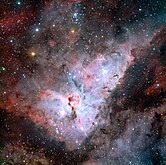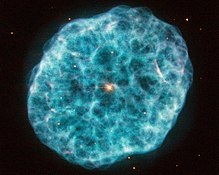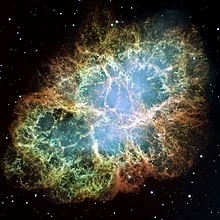|
|
| |
|
|
| |
|
|
|
|
| |
 |
| The Carina Nebula is
an example of a diffuse nebula. |
Nebulae
A nebula is an interstellar cloud of dust, hydrogen,
helium and other ionized gases in a galaxy.
The Persian astronomer, Abd al-Rahman al-Sufi, mentioned
a true nebula for the first time in his book, Book of
Fixed Stars (964). He said that there was a "little
cloud" near the Andromeda galaxy.
Most nebulae are of vast size; some are hundreds of
light-years in diameter. A nebula that is visible to the
human eye from Earth would appear larger, but no
brighter, from close by. The Orion Nebula, the brightest
nebula in the sky and occupying an area twice the
angular diameter of the full Moon, can be viewed with
the naked eye but was missed by early astronomers.
Although denser than the space surrounding them, most
nebulae are far less dense than any vacuum created on
Earth – a nebular cloud the size of the Earth would have
a total mass of only a few kilograms. |
|
 |
| The "Pillars of
Creation" from the Eagle Nebula. Evidence from
the Spitzer Telescope suggests that the pillars
may already have been destroyed by a supernova
explosion, but the light showing us the
destruction will not reach the Earth for another
millennium. |
Origin
A nebula is usually made up of hydrogen gas and plasma.
It may be the first stage of a star's cycle, but it may
also be one of the last stages.
Many nebulae or stars form from the gravitational
collapse of gas in the interstellar medium or ISM. As
the material contracts, massive stars may form in the
center, and their ultraviolet radiation ionises the
surrounding gas, making it visible at optical
wavelengths.
The size of these nebulae, known as H II regions, varies
depending on the size of the original cloud of gas.
These are sites where star formation occurs. The formed
stars are sometimes known as a young, loose cluster.
Some nebulae are formed as the result of supernova
explosions, the death throes of massive, short-lived
stars. The materials thrown off from the supernova
explosion are ionized by the energy and the compact
object that it can produce. One of the best examples of
this is the Crab nebula, in Taurus. The supernova event
was recorded in the year 1054 and is labelled SN 1054.
The compact object that was created after the explosion
lies in the center of the Crab Nebula and is a neutron
star.
Other nebulae may form as planetary nebulae. This is the
final stage of a low-mass star's life, like Earth's Sun.
Stars with a mass up to 8-10 solar masses evolve into
red giants and slowly lose their outer layers during
pulsations in their atmospheres. When a star has lost
enough material, its temperature increases and the
ultraviolet radiation it emits can ionize the
surrounding nebula that it has thrown off. The nebula is
97% Hydrogen and 3% Helium with trace materials.
In the past galaxies and star clusters were also called
'nebulae', but no longer. Nebulae can be sorted by what
they look like and why we can see them. |
|
 |
| The Oyster Nebula is
a planetary nebula located in the constellation
of Camelopardalis. |
Star-forming regions and
diffuse nebulae
Large regions of ionized hydrogen gas are produced by
star-forming regions. Nebulae are often star-forming
regions, such as in the Orion complex. In these regions
gravitation pulls together gas and dust. Material clumps
together to form larger masses, which attract further
matter. Eventually this become massive enough to form
stars. The material left over may form planets and other
planetary system objects.
Emission nebulae / H II
regions
Emission nebulae make their own light. They are often
called H II regions, because it is the ionized hydrogen
which makes them glow. Usually the gases in an emission
nebula are ionized. This makes them emit light and
infra-red radiation.
Reflection nebulae
Reflection nebulae reflect light from nearby stars.
Dark nebulae
Dark nebulae do not emit light or reflect light. They
block the light from stars that are far away. |
|
 |
| The Crab Nebula, an
example of a supernova remnant. |
Planetary nebulae
Planetary nebulae are quite common, because they are
produced by red giant stars late in their lives. These
stars usually become white dwarfs, leaving behind an
expanding ball of ionized gas, which we see as a roughly
circular bright nebula.
Supernova remnants
A supernova occurs when a high-mass star reaches the end
of its life. When nuclear fusion in the core of the star
stops, the star collapses and explodes . The expanding
shell of gas forms a supernova remnant. The Crab nebula
is a supernova remnant which probably exploded in 1054
AD. Light and X-ray emission from supernova remnants
comes from ionized gas. There is a huge amount of radio
emission called synchrotron emission. This emission
originates from high-velocity electrons oscillating in
magnetic fields. |
|
 Kiddle:
Nebulae Kiddle:
Nebulae
Wikipedia: Nebulae |
|
|
|
|
|
|
|
|
|
|
|
|
|
|
|
|
Search Fun Easy English |
|
|
|
|
|
|
|
|
|
|
|
|
|
|
|
About
Contact
Copyright
Resources
Site Map |